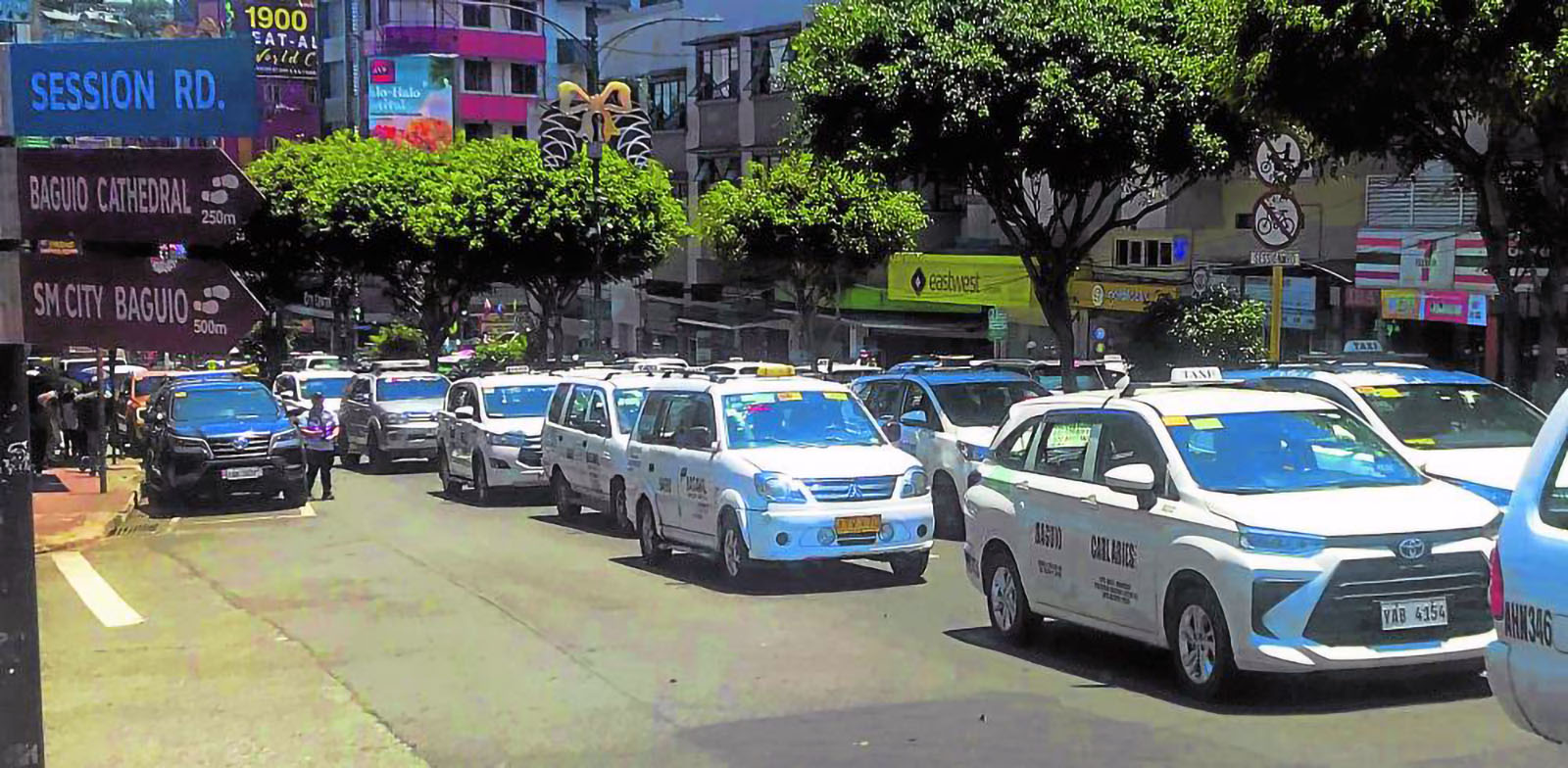Baguio ‘congestion fee’ plan draws flak

BUMPER TO BUMPER Several companies have offered to introduce automated traffic regulators and a transport hub to manage vehicle flow and solve gridlocks in Baguio City, the country’s
summer capital. Tourists add 20 percent to the 70,000 local vehicles using roads built for a much smaller population. —VINCENT CABREZA
BAGUIO CITY — At least 25,000 vehicles driven by tourists here on weekends continue to worsen the congestion of city roads, which are also being shared by 53,000 to 60,000 cars, vans, and modern jeepneys owned by residents.
This was revealed by a recent survey presented last week by a tollways company at a public consultation here.
The volume of midweek traffic also showed that between 69,800 and 72,000 Baguio-based vehicles use city streets at the start of the week, which may justify the collection of congestion fees of as high as P250 during peak hours to discourage residents and tourists from driving to downtown Baguio whenever gridlocks occur, the Metro Pacific Tollways Corp. said at a briefing on June 5.
READ: Baguio eyes ‘congestion fee’ for visitors
The company operates tollways like the North Luzon Expressway. It has been granted original proponent status for its unsolicited proposal to put up a P2.5-billion “smart mobility system” for Baguio that will regulate traffic flow and parking and deploy public transport using artificial intelligence (AI).
Article continues after this advertisementBut the briefing quickly drew flak on social media, as many argued that the proposed fee was high.
Article continues after this advertisementThe June 5 presentation also heard the proposal by Megawide Construction Corp. to build a P1.2-billion intermodal terminal for public utility vehicles like buses, similar to the facility it operates in Parañaque City.
However, passengers arriving in or leaving the city would have to shoulder a P30 terminal fee, which also upset some residents participating in the consultations.
Mayor Benjamin Magalong said these were suggestions made public but would still undergo negotiations while drafting public-private partnership contracts and were therefore not enforceable.
On Wednesday, the mayor said his administration encouraged citizen participation in decision-making and would ensure “their voices are not just heard, but respected and integrated into how we govern.”
Legal basis
A congestion fee (also called mobility fee) was first discussed in 2022 and was a topic of the city council’s Sept. 11, 2023, inquiry into Baguio’s gridlocks.
The congestion fee has legal standing, according to an April 14, 2023, legal opinion by Undersecretary Juan Victor Llamas of the Department of the Interior and Local Government, who said it adhered to Section 16 or the general welfare clause of Republic Act No. 7160 (Local Government Code), provided the toll was not “oppressive.”
READ: Baguio in focus
Designed and built by the American colonial government for only 25,000 people, Baguio’s population has grown to 366,358 (as of the 2020 census) and its narrow roads (349 kilometers in total), could only accommodate 145,416 people, according to a 2019 urban carrying capacity study.
Speaking at the June 5 consultations, Magalong stressed that the mobility fee needed to be steep so motorists would voluntarily avoid streets with heavy traffic.
He said the fees would be interdependent with three other features of automated traffic management.
Smart mobility also involves an “advanced traffic management system” so traffic signals are more flexible based on road conditions; the construction of parking buildings with 22,000 public parking slots, which AI would oversee to guide motorists to available spaces; and an AI tracking system that regulates the deployment of jeepneys and taxis.
Master plan
Magalong said the city had developed a smart mobility master plan using a grant from Singaporean firm ST Engineering, which recently partnered with Metro Pacific.
A four-month study conducted last year by the Baguio government drew up an inventory of vehicles on busy city streets, which was partly confirmed by the Metro Pacific survey, he said. The mayor said trucks, buses, and passenger vans made up 3 percent (5.55 percent in Metro Pacific’s study), while motorcycles made up 16 percent (20.47 percent in Metro Pacific’s tally).
Magalong said 31 percent (39.67 percent for Metro Pacific) are private cars.
He said taxis made up 42 percent (26.04 percent in the Metro Pacific report) of vehicles in Baguio streets, while jeepneys, “which transport the most passengers,” represent only 8 percent (8.28 percent for Metro Pacific).
Metro Pacific said “the ratio of taxis to jeepneys is 3:1, highlighting a significant imbalance in the city’s public transportation distribution.”
The company’s data showed 39,004 taxi trips were made during their survey period, compared to 13,070 jeepney trips.
Magalong said Metro Pacific’s survey revealed that “tourists were not the main drivers of traffic congestion.”